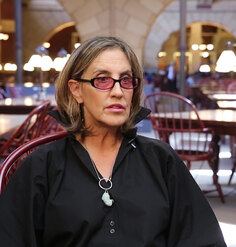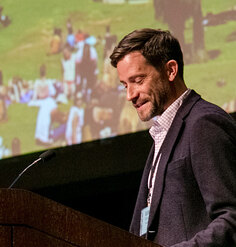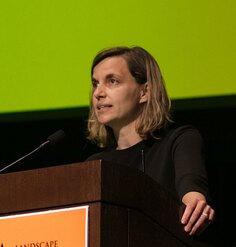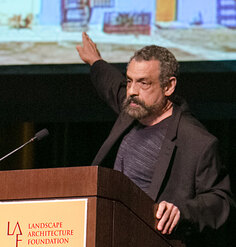For Landscape-Led Urbanism
By Henri Bava
This presentation was part of the Landscape Architecture Foundation’s The New Landscape Declaration: A Summit on Landscape Architecture and the Future held in Philadelphia on June 10-11, 2016. LAF asked a diverse group of leading minds to write a “Declaration” reflecting on the last half century and offering bold ideas for how landscape architecture can make its vital contribution in response to the challenges of our time.
Henri Bava
Founding Partner, Agence TER
Karlsruhe, Germany
Henri Bava is founding partner of Agence TER, with offices in Paris, Karlsruhe, and Los Angeles. He studied plant biology at the Université Paris-Sud, Orsay; scenography at Ecole Jacques Lecoq, Paris; and landscape architecture at the Ecole Nationale Supérieure de Paysage (ENSP), Versailles. Since 1998, Bava has been chairman of the Landscape Architecture Department at the Karlsruhe Institute of Technology (KIT) in Germany.
* Affiliation at the time of the Summit
For Landscape-Led Urbanism
by Henri Bava
In the face of the combined phenomena of climate change, increasing population, and the growing urbanization of our societies with their consequent economic disparities, we need profound and lasting transformation. Each of us, consciously or not, is implicated because every one of our actions has a consequence.
Landscape architects must call on their culture, their experience, and their knowledge to invent and encourage innovative solutions, to transform their actions and ways of thinking, anticipating mutations in our cities and adapting to this new context in constant evolution, using landscape, populations, and habits.
The urban projects of landscape architects—be they local or territorial—must be situated within and supported by their geography, acting within ecosystems, biocenoses, and biotopes.
The Earth
We are human beings on a planet, Earth, the same as the material with which we work. We are linked to and dependent upon this substance. It is not by chance that the words humus and human have the same origin, as humus is the source of life, permitting the soil to stock nutritive minerals, water, and carbon.
The quality of humus depends on the way it is cultivated and worked, as it is not the natural soil. It is changed by man’s labor. The farmer cultivates the land before planting, maintaining, and reinforcing its living qualities—its intense, subterranean life which allows plants to germinate, develop, and flourish.
In every project, landscape architects can take inspiration from generations of farmers and support the development of humus in soils, decisive for the future of humanity. We must preserve the quality of our soils to avoid their exhaustion through the overuse of fertilizers, to keep their ability to retain water, and to maintain their porosity so that they remain open and oxygenated. Agroecology can spread at both local and global scales, with agro/urban projects, community gardens, and shared gardens. The quality of our soils, even in our cities, is as essential as the quality of the air we breathe.
Water
Water is in constant motion, and the water we drink has already been drunk. To maintain future access to safe drinking water, we must develop alternatives to the heavy and expensive infrastructure of the past. Urban sprawl and increasing soil impermeability raise the risk of both flooding and water shortages. Among the most environmentally friendly models devised to secure the supply of water are those that produce water at a very local level, on the block or in the neighborhood, or mixed systems that retain the public water system for drinking water and have local systems for recycling graywater and rainwater for other uses.
Water in movement can bring sudden, radical changes, with associated risk for populations. We need to understand the dynamics of the water network and transform the risk into project potential, with creative responses to changing and unknown factors.
Successful water management in the metropolises must account for water quality and potability; safety and security; the environment; and resolution for the articulation of water with the city while reinforcing the ecological corridors generated by the rivers to form a landscape structure at the territorial scale.
We must recover the natural banks of rivers and their riparian forests within the city, making them visible and accessible to promote awareness and ownership by the people.
Working with the living
To work with the living is to promote diversity and to understand the ecosystems present in each project, not merely preserving the existing but encouraging a richer biodiversity while increasing the number of inhabitants.
The living is the main material—with all that implies: carbon storage in food crops, the true fuel of human beings, but also storing carbon with perennial plants, most notably trees, at the center of strategies for carbon capture and energy storage. Maintaining the biodiversity reservoirs that are the wastelands in and around cities is necessary and will mean changing our views on these rich and complex spaces.
The well-being of populations
We as landscape architects must encourage everyone to become involved in maintaining the well-being of populations—that quality of people living well together, place by place, with ownership of a project and participation in its realization.
Cohesion and social diversity, accessibility of services, a favorable environment for active mobility, a healthy community, a pleasant living environment—all are necessary. However, developing appropriate responses to political and social realities is not simple; it takes time. The knowledge that we are faced with this complexity, on the one hand, and the undeniable link between the quality of the environment and the health of populations, on the other hand, are worth sharing—becoming enriched through interdisciplinary and intersectoral reflection, and augmented by research.
Density, compactness, and fertility
We must avoid urban sprawl and encourage the dense and fertile city by establishing nature in the city. This is in no way a contradiction: density is not antithetical to nature in all its forms—on roofs, streets, or squares—promoting project ownership by human inhabitants, with their activity bringing life to the project.
Density is associated with the issue of mobility, transportation with little or no pollution, clean air, energy conservation, and renewable energies, and forming part of the equation for virtuous cities.
When these elements are in synergy, they create the conditions for a new paradigm in which landscape architects in particular must play their full part in the design of the cities, landscapes, and territories of tomorrow, directing design teams in the respect of sites and landscapes, to install a landscape-led urbanism.











